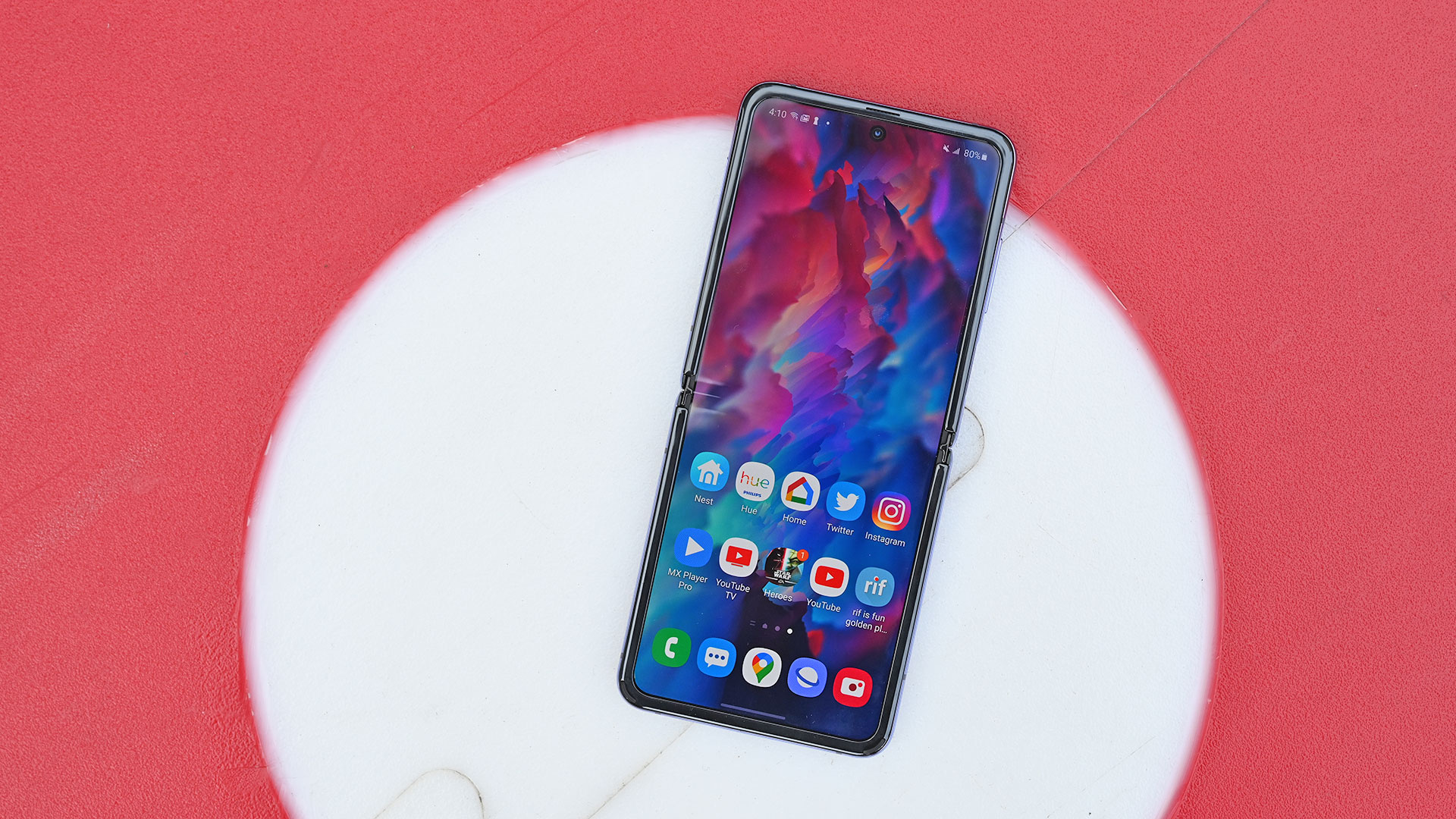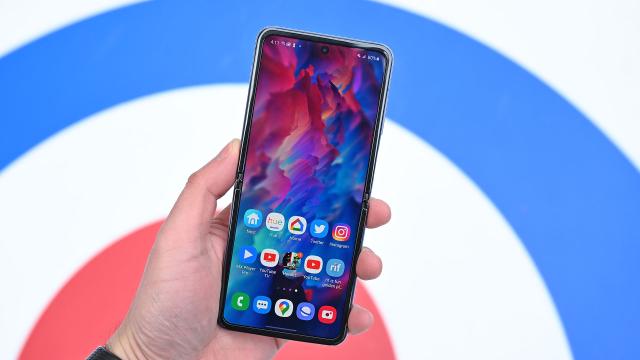With all the hazards and issues found on previous foldable phones, it’d be hard to blame anyone for writing off flexible screen tech completely. But that sentiment might be a bit premature, because with the Galaxy Z Flip, Samsung has made the first foldable phone worth caring about.
Editor’s Note: The Galaxy Z Flip does not have Australian pricing or a local release date yet.
Honestly, the biggest compliment I can give the Z Flip is that it feels a lot like a traditional smartphone, but with the ability to bend the screen in half and end calls by slamming the phone shut, which is really goddamn satisfying. Now I admit the part about functioning as a normal phone might not sound like much, especially for something that costs $US1,400 ($2,117), but it really is a massive improvement, enough for me to say that the Z Flip feels like a more refined, second-gen take on foldable tech.
That’s because with previous bendy phones like the Galaxy Fold, Huawei Mate X, and the new Moto Razr, it seemed like you had to give them a white glove treatment while standing inside a hermetically sealed room just to prevent particles from getting inside or the screen from falling apart. But with the Z Flip, there’s a sort of understated confidence. When closed, it’s a compact package that lets you stash it practically anywhere (even in tiny clutches and many of the impractically small pockets they put on women’s pants), while also being quite comfortable to hold.

Samsung Galaxy Z Flip
What is it?
A modern flip phone with a 6.7-inch foldable screen
Price
$US1,380 ($2,086)
Like
Slick, compact design, solid battery life, more durable screen and hinge, side-mounted fingerprint sensor
Don't Like
Mono speakers, very limited water resistance, exterior cover screen could be bigger, somewhat difficult to open with one hand, expensive
And when it’s open, the Z Flip expands to reveal a 6.7-inch 2636 x 1080 FHD+ screen with a 10-MP punch-hole selfie cam (which Samsung claims is a first for a phone with a bendy screen). Considering the phone is essentially a 3.5-inch by 2.9-inch rectangle when folded, it’s pretty impressive how much screen real estate you can get out of such a small package. For comparison’s sake, the Galaxy S20 Ultra—which has a massive 6.9-inch display—is basically the same size as the Z Flip with its screen fully deployed—but you can’t fold the S20 Ultra in half for better portability.
Around the edge of the phone, there’s a plastic bezel that helps protect the Z Flip from damaging its display when you slam it shut, while also ensuring that if any small particles do get caught inside, they won’t grind on the Z Flip’s display. And on the right side, there’s a speedy fingerprint sensor built into the phone’s lock button and a volume rocker, which both work well. I just wish they were positioned a bit lower on the phone for easier use while the phone is unfolded.
As for the Galaxy Z Flip’s ultra-thin glass screen, it’s sort of like two steps forward, but one step back. That’s because while it feels a lot like a traditional glass screen, as we’ve seen in teardown videos, for some reason Samsung also put a plastic film on top of the glass, which is what your fingers are actually touching.
Sadly, this means the even though the entire display feels stronger and more substantial, it’s still prone to dings from things like keys, pens, or even your fingernails if you press hard enough. And while the crease from the Galaxy Fold has returned, it’s not quite as obvious when the screen is on, particularly when seen from normal viewing angles. But it’s there and you can feel it too, though I find it’s not really an issue as I don’t really touch the middle of the screen that much, even when scrolling through things like Twitter feeds, websites, and more.
Also, it’s important to go into the Z Flip’s settings and turn Finger Sensor gestures on, which allows you to open the notification shade by swiping down on the fingerprint reader. Otherwise, the Z Flip’s extra tall 21:9 aspect ratio can make it difficult to reach the top of the screen with one hand.
Meanwhile, on the outside, the Z Flip sports a tiny 1.1-inch cover screen which you can use to check notifications, view calendar alerts, or change music. Alternatively, you can use the Z Flip’s cover screen as the world’s smallest viewfinder when taking selfies, but the screen is so small, sometimes it’s a challenge to even fit your entire head in the display. I’m sort of conflicted. I feel like I would have liked a larger display, but at the same time, in a world where apps and social media are constantly begging for your attention, seeing fewer notifications isn’t necessarily a bad thing. And on top of that, forcing people to use the Z Flip’s main display to do anything meaningful simply means you get to open and close the phone more often, which is always a treat.
Most of those issues aren’t really a big deal, as the Z Flip’s design protects the display when closed, but you’re going to want to refrain from letting people or pets dig their claws in there. The Z Flip also isn’t really water-resistant, because while Samsung did coat the phone’s internals with a hydrophobic coating, that’s more to protect against mist or moisture than a full dunk in the sink.
Samsung also put tiny brushes inside the Z Flip’s beefy hinge, to prevent dirt and dust from getting inside, but only time will tell how well that’ll work. So in the end, while the Z Flip is definitely more durable than previous foldable phones—particularly its body, screen, and hinge—it’s not quite a chuckable as a traditional glass sandwich handset (which aren’t very chuckable to begin with).
Thankfully, the Z Flip’s specs are solid (and way better than the mid-range components you get on the Moto Razr), because while you don’t get a headphone jack or a microSD card slot (both becoming harder and harder to find on flagship phones anyway), you do get a Qualcomm Snapdragon 855+ chip, 8GB of RAM, and 256GB of storage to make up for the Flip’s lack of expandability.
Battery life is also surprisingly decent, as the Z Flip lasted 13 hours and 29 minutes on our video rundown test, which is an hour longer than what we got from the Pixel 4 XL (12:36), about the same as the OnePlus 7 Pro (13:36), but still short of the Galaxy S10+ (15:09). The one curiosity to me though is that the Z Flip only uses its earpiece for calls unlike practically every other recent Galaxy phone. That means you only get mono sound from the Flip’s bottom-mounted speaker.
When it comes to snapping pics, the Z Flip’s rear 12-MP main cam and 12-MP ultra-wide camera are practically the same as what you get on a Galaxy S10, but with slightly better image processing. Pics generally look good, but you’re not getting the new and improved cams with bigger sensors Samsung installed on the new Galaxy S20 line. And as with previous Galaxy phones, the Z Flip tends to capture pics with an overly yellow colour cast compared to other phones. Phones such as the Pixel 4 offer better white balance. Also, while not having a telephoto cam isn’t a deal-breaker, it’s still kind of a bummer that the Z Flip didn’t get one.
However, despite shortcomings like the lack of real water resistance and a screen that’s sturdy but still not as durable as real glass, the Z Flip is a triumph. It’s impressive to see how much things have improved since the Galaxy Fold. By eliminating the panel gaps and squishy screen on the Fold, Samsung has transformed the Z Flip into something you’re not scared to carry around. Its smaller dimensions are a delight to hold, and nifty tricks like being able to open the phone 90 degrees to turn the phone into its own little tripod while taking pics are more useful than you might imagine.
That makes the Z Flip’s biggest hurdle its price (and availability). But as the original Razr proved more than 15 years ago, there’s plenty of room in the world for a more lifestyle-focused phone with above-average specs. And compared to the new Razr, the Z Flip has it beat in nearly every single way. Cost, specs, battery life, cameras, and durability. The Z Flip is here to correct the mistakes of previous foldables, to the point that you might even consider buying one. Which is exactly what I did.
Now I’m not saying anyone should spend $US1,400 ($2,117) on a phone. I bought one because I was morbidly curious and wanted to test how the Z Flip and Samsung’s ultra-thin glass holds up over time. But after having one for just shy of a week, the big takeaway is that the Z Flip proves foldable phones are much more than a fad.
README
-
Yes, the Z Flip still has a crease, but it’s a bit less obvious and the screen is overall much stronger and durable.
-
Even though Samsung coated the inside of the phone with hydrophobic nano-particles, the phone still isn’t what you’d call water-resistant.
-
Battery life and performance are both solid, and the side-mounted fingerprint sensor is very speedy.
-
There are few gadget-related joys better than slamming a phone shut, especially when you’re not worried about breaking the thing.
-
The Z Flip is harder to open with one hand than you’d really like.
[referenced url=”https://gizmodo.com.au/2020/02/samsung-galaxy-z-flip-australia/” thumb=”https://gizmodo.com.au/wp-content/uploads/2020/02/z-flip-3-410×231.jpg” title=”Samsung’s Galaxy Z Flip Isn’t Coming To Australia Yet” excerpt=”Just like last year, Samsung Unpacked 2020 saw not only one new series launch, but two. After months of leaks and rumours Samsung’s brand new clamshell foldable, the Galaxy Z Flip, has been revealed. But while the rest of the world this week, Australia has to wait.”]
